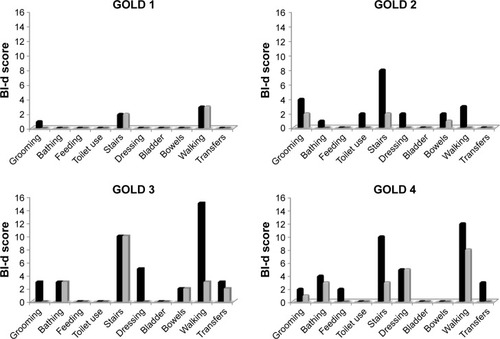Dear editor
We read the remarkable letter by Chuang.Citation1 We thank him for his valid suggestions on our paper. Interestingly, he focused on the two dimensions of the Barthel index-dyspnea (BI-d), which was exactly our goal. As rehabilitators, our goal is to provide patients with physical therapy depending on their health status and to improve their respiratory function.
We need to verify and demonstrate the efficacy and the outcomes of respiratory rehabilitation, supported by physical therapy. For these reasons, we need an assessment device that measures respiratory improvement during daily motor activities that should be monitored.
The modified Barthel indexCitation2 is a well-consolidated and widely used instrument to assess the performance of a person in a predetermined and fixed set of activities of daily living (ADLs). By proposing BI-d,Citation3 we aimed to develop a scale to measure how dyspnea precludes or reduces the same ADLs, with the ultimate goal of globally assessing the effectiveness of rehabilitation. Hence, an assessment method that measures the impact of dyspnea on activities monitored by a rehabilitation program is of utmost importance for rehabilitators.
Large part of Chuang’s letter is based on the Chronic Respiratory Questionnaire-dyspnea (CRQ-d). The CRQ-d is a health-related quality of life (health status) questionnaire, with a dyspnea “domain”.Citation4 However, for our purposes, the CRQ-d is too individualized as each subject selects five activity items – “the most important” – out of 26 listed activities. Therefore, each subject may choose different items from other subjects in the same study group. Due to this significant methodology, CRQ was standardized recently into a version that contains a total of only five items with a dyspnea domain, all of which have to be responded.Citation5
Conversely, the modified Barthel indexCitation2 includes a predetermined and fixed set of ADLs. This allows better comparison between subjects or group of subjects, before and after a treatment, a significant criterion in rehabilitation, and a specific field for which we mainly developed the scale. Moreover, CRQ-d is dyspnea centered, whereas BI-d is activity centered.
This first paper on BI-d validation is auspicious. The metric qualities are good and the variability is acceptable, with 95% confidence intervals of correlation coefficient of BI-d versus 6-minute walking test being −0.609 and −0.352, respectively.
As pointed out in our paper, additional studies in respiratory rehabilitation programs are required to further assess the applicability of the scale in a broadest context. Mild COPD patients are among those populations who are potential candidates of BI-d. Dr Chuang showed accurately that only 8.1% of our study population had mild COPD. This is obvious as COPD is largely underestimated, and patients usually consult a specialist only when they are diagnosed with GOLD 2Citation6 stage disease.Citation7–Citation9 and show a few outcomes of four subjects based on the four GOLD stages. They also show that the less obstructed the patient, the lower the BI-d was. Conversely, the more obstructed the patient, the higher the BI-d was. After pulmonary rehabilitation, the BI-d improved in all patients. The best results were observed in GOLD 4 stage as they received a more intensive health care and rehabilitation program. On the other hand, the smallest limitation was assessed at the baseline, and the smallest differences in outcome were observed in subjects at GOLD 1 stage.
Table 1 Four clinical cases according to GOLD severity criteria of obstruction: stages 1–4
Figure 1 Mean score distribution of each Barthel dyspnea item measured at the baseline (black columns) and at the end (gray columns) of the rehabilitation program. Subjects were subdivided according to GOLD severity grade.

Conclusion
In conclusion, we consider it appropriate to uphold all items of both the modified Barthel index score (because they collect important information from a physical rehabilitation point of view) and of the Barthel dyspnea index (because they allow the estimate of the outcome of a specifically tailored respiratory rehabilitation program).
Disclosure
The authors report no conflicts of interest in this communication.
References
- ChuangMLThe Barthel index-dyspnea: a new two-dimensional dyspnea scaleInt J Chron Obstruct Pulmon Dis2016111843184427536096
- ShahSVanclayFCooperBImproving the sensitivity of the Barthel index for stroke rehabilitationJ Clin Epidemiol19894287037092760661
- VitaccaMPaneroniMBaiardiPDevelopment of a Barthel index based on dyspnea for patients with respiratory diseasesInt J Chron Obstruct Pulmon Dis2016111199120627354778
- LacasseIWongEGuyattGHIndividualising questionnairesJoyceCRBO’BoyleCAMcGeeHIndividual Quality of LifeAmsterdamHarwood Academic Publishers199987104
- SchünemannHJGriffithLJaeschkeRA comparison of the original chronic respiratory questionnaire with a standardized versionChest200312441421142914555575
- RabeKFHurdSAnzuetoAGlobal strategy for the diagnosis, management, and prevention of chronic obstructive pulmonary disease: GOLD executive summaryAm J Respir Crit Care Med2007176653255517507545
- BuistASMcBurnieMAVollmerWMBOLD Collaborative Research GroupInternational variation in the prevalence of COPD (the BOLD Study): a population-based prevalence studyLancet2007370958974175017765523
- GuerrieroMCaminatiMViegiGSennaGCesanaGPomariCCOPD prevalence in a north-eastern Italian general populationRespir Med201510981040104726052037
- KimVCrinerGJThe chronic bronchitis phenotype in chronic obstructive pulmonary disease: features and implicationsCurr Opin Pulm Med201521213314125575367
